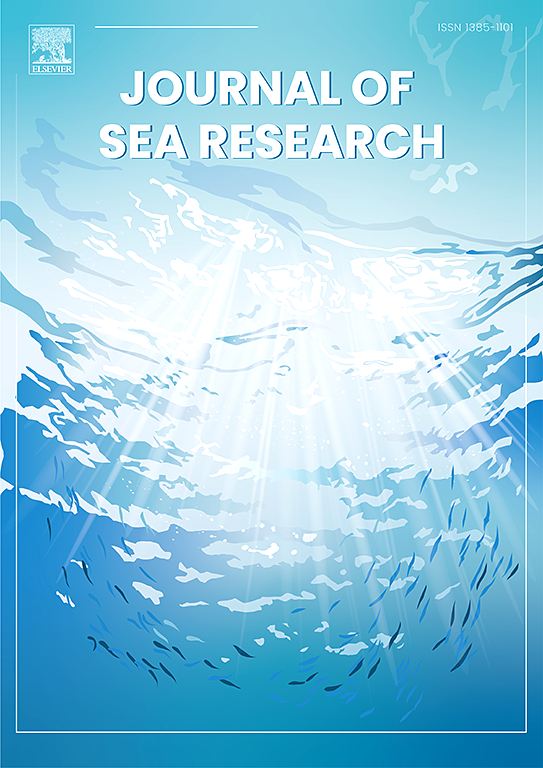The distribution and characteristics of suspended particulate matter in the Palau-Caroline seamount area of the western tropical Pacific Ocean
IF 2.9
4区 地球科学
Q2 MARINE & FRESHWATER BIOLOGY
引用次数: 0
Abstract
Suspended particulate matter (SPM) plays an important biogeochemical role in aquatic systems, and assessing SPM spatial trends during the current climate change period is important. In the autumn of 2018, seawater samples were collected from depths of 1, 20, 50, 100and 200 m in the water column at 62 stations within the Palau-Caroline seamount area in the western tropical Pacific Ocean. The SPM concentration was measured to assess spatial variability. The particulate nitrogen (PN) concentration, particulate organic carbon (POC) concentration, and δ13CPOC were measured at 30 stations to assess spatial variability and the source of the suspended particulate organic matter (POM). The SPM concentration ranged from 0 to 1.18 mg/L, with an average value of 0.18 ± 0.20 mg/L, which is consistent with the results of previous studies in the ocean. Marked variation was observed in the SPM distribution. High SPM concentrations were observed around the seamount area, indicating that the seamount significantly influenced the distribution of the SPM. The POC concentrations decreased with depth, whereas the PN concentrations did not exhibit a clear distribution pattern. This difference in distribution suggested that the sources, cycling pathways and other controlling geochemical processes differed between POC and PN. The C/N ratios were notably low, ranging from 0.4 to 8.3, with an average of 2.0 ± 1.6. The δ13CPOC values ranged from −27.7 ‰ to −23.4 ‰, showing clear stratification with higher (less negative) values in the upper water column. The distribution characteristics of POC, PN, δ13CPOC, and the C/N ratio indicate that small phytoplankton may influence the POM characteristics of the upper water column. The POM collected in the study area appears to be derived mainly from in situ biological production.
热带西太平洋帕劳-卡洛琳海山区悬浮颗粒物的分布与特征
悬浮颗粒物(SPM)在水生系统中发挥着重要的生物地球化学作用,评估当前气候变化时期SPM的空间变化趋势具有重要意义。2018年秋季,在热带西太平洋帕劳-卡洛琳海山地区62个站点的水柱深度分别为1、20、50、100和200 m,采集了海水样本。测量SPM浓度以评估空间变异性。通过30个站点的颗粒态氮(PN)浓度、颗粒态有机碳(POC)浓度和δ13CPOC浓度的测定,探讨悬浮颗粒态有机物(POM)的空间变异及其来源。SPM浓度范围为0 ~ 1.18 mg/L,平均值为0.18±0.20 mg/L,与以往海洋研究结果一致。SPM分布有明显变化。在海山附近,SPM浓度较高,表明海山对SPM的分布有显著影响。POC浓度随深度降低,而PN浓度没有明显的分布规律。这种分布差异表明POC和PN的来源、循环途径和其他控制地球化学过程存在差异。C/N值较低,介于0.4 ~ 8.3之间,平均值为2.0±1.6。δ13CPOC值在−27.7‰~−23.4‰之间,分层明显,上层水体δ13CPOC值高(负),上层水体δ13CPOC值低。POC、PN、δ13CPOC和C/N的分布特征表明,小型浮游植物可能影响上层水体的POM特征。研究区收集到的聚甲醛似乎主要来源于原位生物生产。
本文章由计算机程序翻译,如有差异,请以英文原文为准。
求助全文
约1分钟内获得全文
求助全文
来源期刊

Journal of Sea Research
地学-海洋学
CiteScore
3.20
自引率
5.00%
发文量
86
审稿时长
6-12 weeks
期刊介绍:
The Journal of Sea Research is an international and multidisciplinary periodical on marine research, with an emphasis on the functioning of marine ecosystems in coastal and shelf seas, including intertidal, estuarine and brackish environments. As several subdisciplines add to this aim, manuscripts are welcome from the fields of marine biology, marine chemistry, marine sedimentology and physical oceanography, provided they add to the understanding of ecosystem processes.
 求助内容:
求助内容: 应助结果提醒方式:
应助结果提醒方式:


